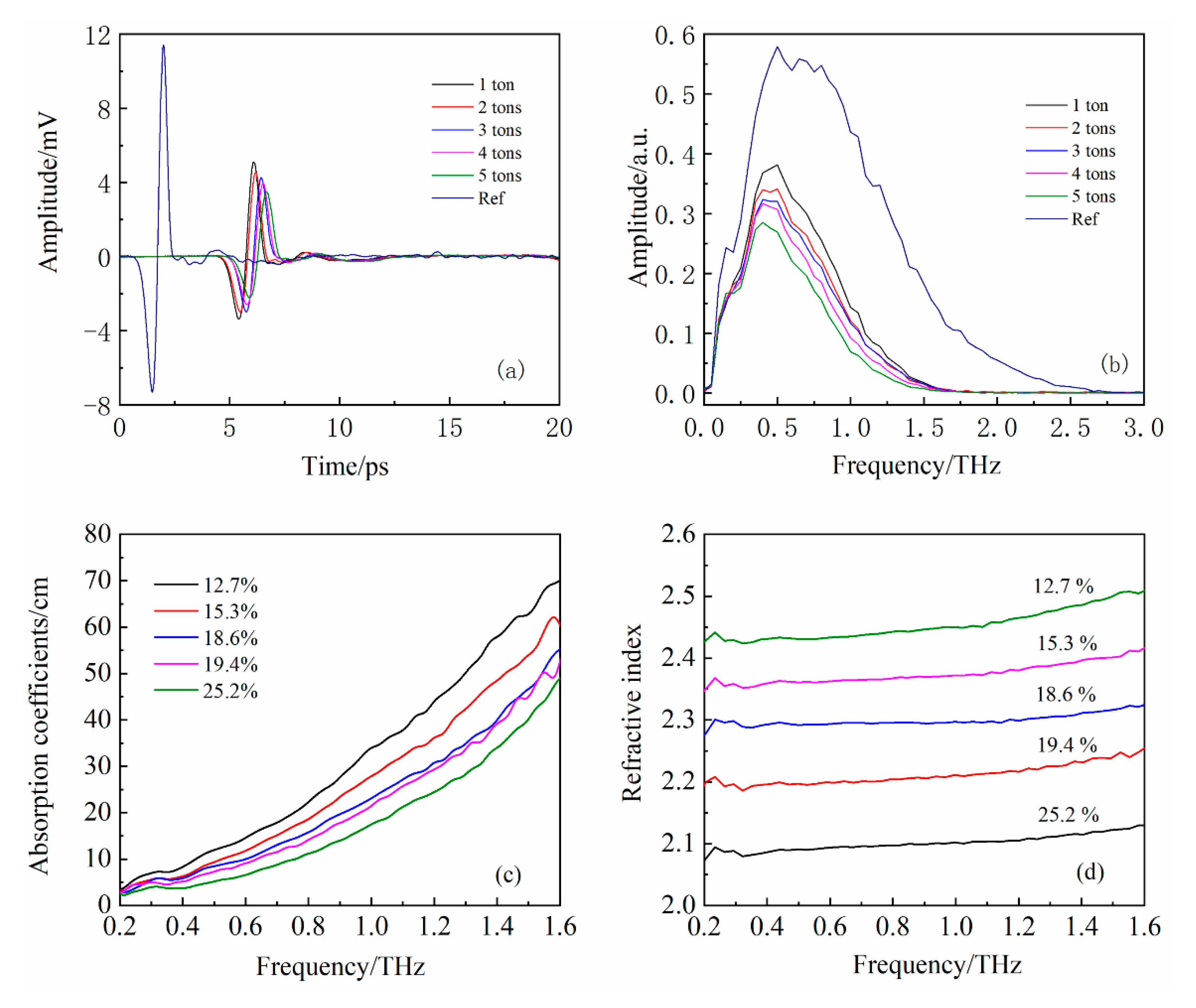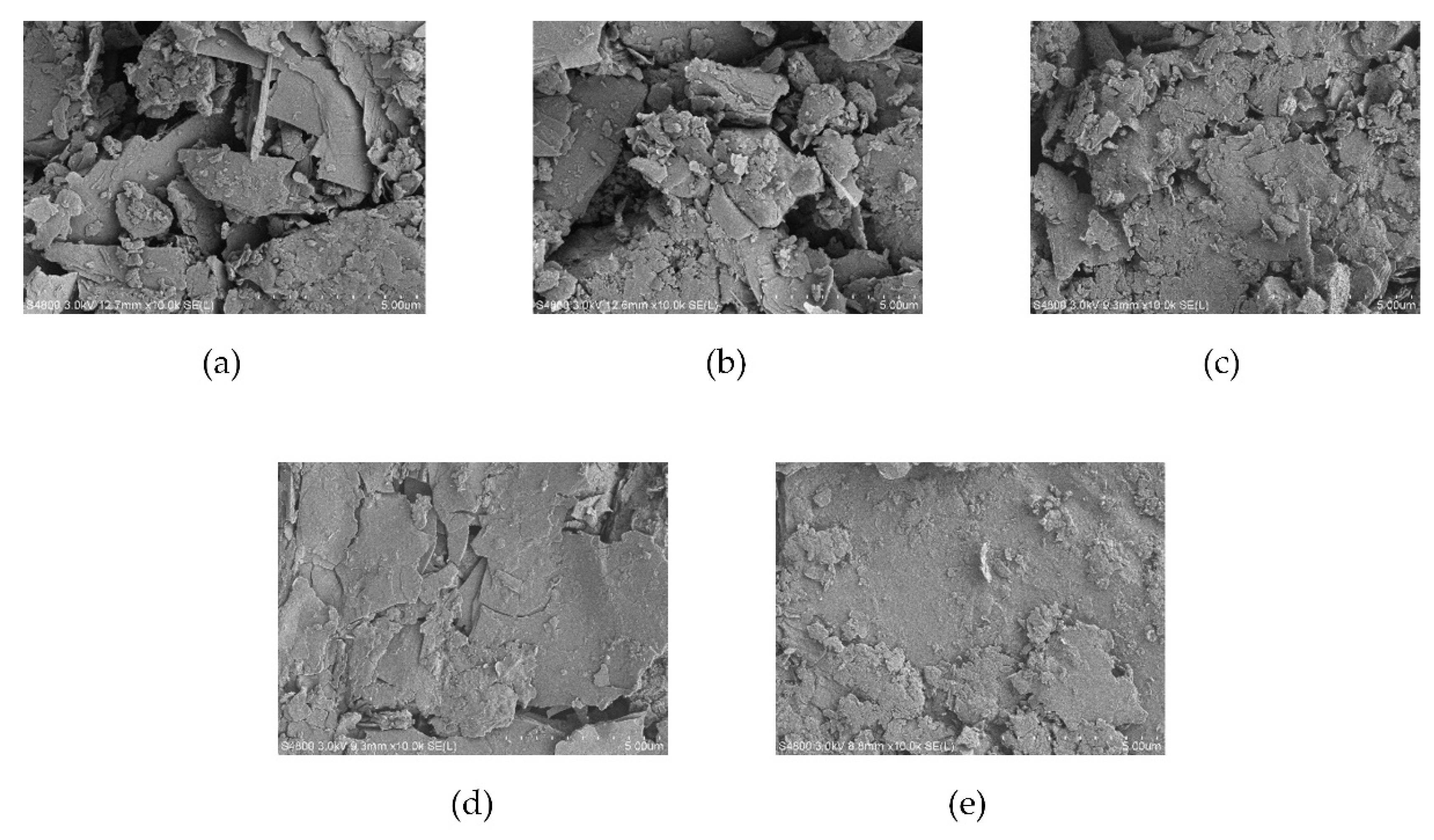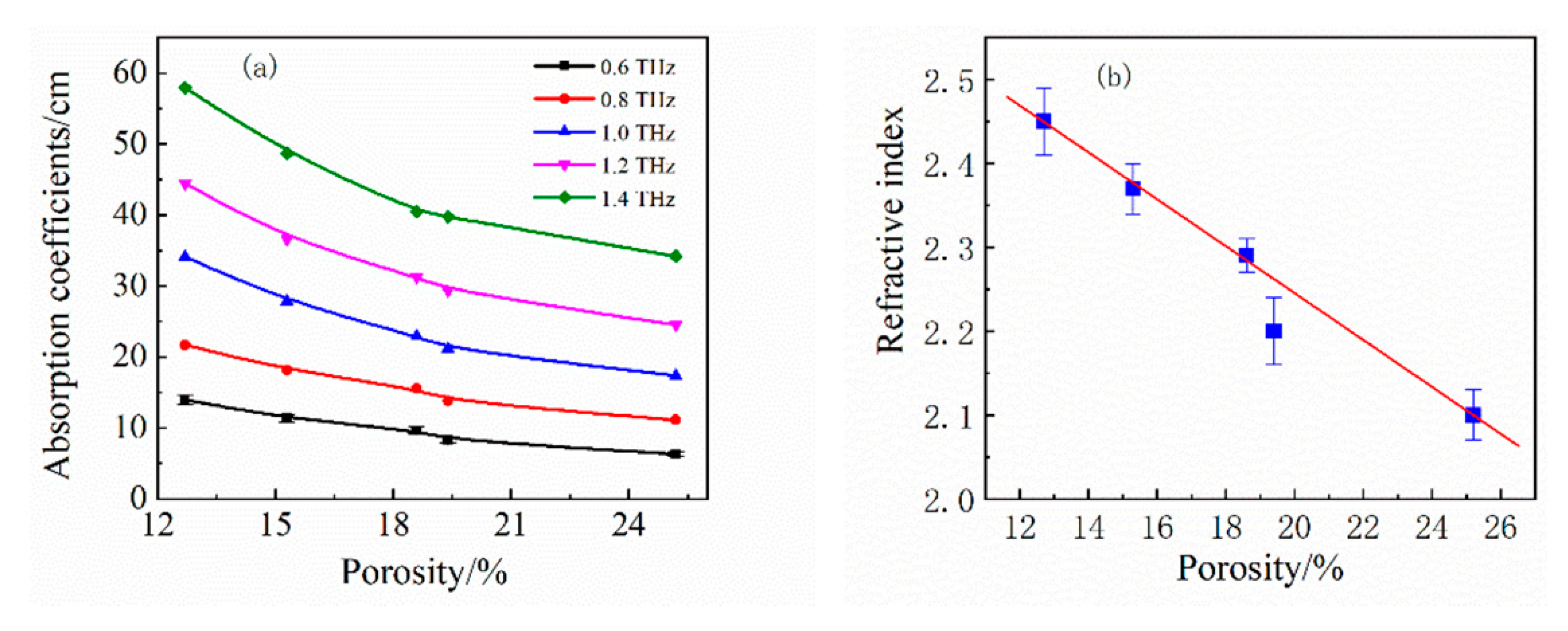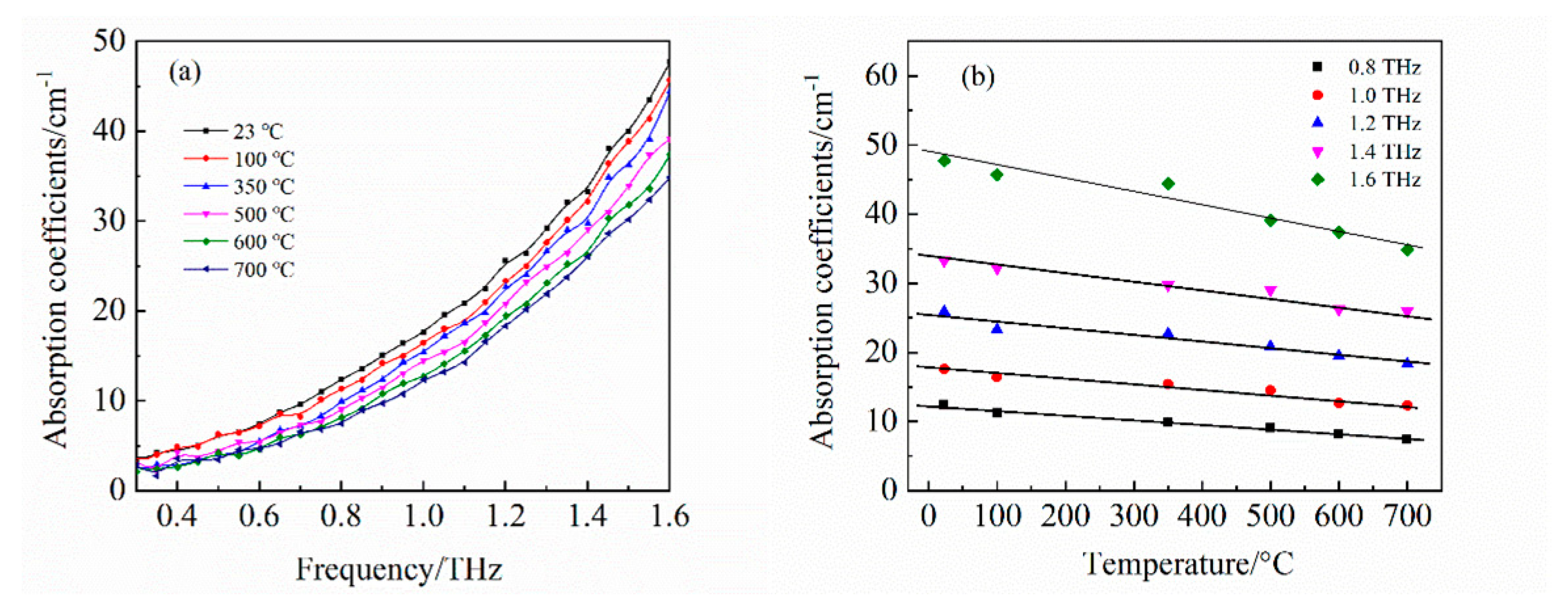Insights into a Mineral Resource Chlorite Mica Carbonate Schist by Terahertz Spectroscopy Technology
Abstract
:1. Introduction
2. Materials and Methods
3. Results and Discussion
4. Conclusions
Author Contributions
Funding
Data Availability Statement
Conflicts of Interest
References
- Dubiński, J. Sustainable Development of Mining Mineral Resources. J. Sustain. Min. 2013, 12, 1–6. [Google Scholar] [CrossRef]
- Aryee, B.N.A. Ghana’s mining sector: Its contribution to the national economy. Resour. Policy 2001, 27, 61–75. [Google Scholar] [CrossRef]
- Zhou, B.; Li, Z.; Chen, C. Global Potential of Rare Earth Resources and Rare Earth Demand from Clean Technologies. Minerals 2017, 7, 203. [Google Scholar] [CrossRef]
- Dumakor-Dupey, N.K.; Arya, S. Machine Learning—A Review of Applications in Mineral Resource Estimation. Energies 2021, 14, 4079. [Google Scholar] [CrossRef]
- Lee, S.; Xu, H.F. Powder XRD and TEM study on crystal structure and interstratification of Zn-chlorite (baileychlore). Powder Diffr. 2017, 32, 118–123. [Google Scholar] [CrossRef]
- Makbul, S.A.A.; Jahan, N.; Ahmad, G. Hajrul yahood (Lapis judaicus): An important mineral drug of Unani system of medicine for the management of urolithiasis. J. Ethnopharmacol. 2018, 222, 165–170. [Google Scholar] [CrossRef]
- Ridgway, C.; Bawuah, P.; Markl, D.; Zeitler, J.A.; Ketolainen, J.; Peiponen, K.-E.; Gane, P. On the role of API in determining porosity, pore structure and bulk modulus of the skeletal material in pharmaceutical tablets formed with MCC as sole excipient. Int. J. Pharm. 2017, 526, 321–331. [Google Scholar] [CrossRef]
- Johansson, B.; Alderborn, G. The effect of shape and porosity on the compression behaviour and tablet forming ability of granular materials formed from microcrystalline cellulose. Eur. J. Pharm. Biopharm. 2001, 52, 347–357. [Google Scholar] [CrossRef]
- Wang, Y.; Feng, F.; Wang, Z. Determination of Selected Elements in Aqueous Extractions of a Traditional Chinese Medicine Formula by ICP-MS and FAAS: Evaluation of Formula Rationality. Anal. Lett. 2010, 43, 983–992. [Google Scholar] [CrossRef]
- Jang, W.-J.; Kim, H.-M.; Shim, J.-O.; Yoo, S.-Y.; Jeon, K.-W.; Na, H.-S.; Lee, Y.-L.; Lee, D.-W.; Roh, H.-S.; Yoon, W.L. Deactivation of SiO2 supported Ni catalysts by structural change in the direct internal reforming reaction of molten carbonate fuel cell. Catal. Commun. 2017, 101, 44–47. [Google Scholar] [CrossRef]
- Wang, G.; Chang, X.; Yin, W.; Li, Y.; Song, T. Impact of diagenesis on reservoir quality and heterogeneity of the Upper Triassic Chang 8 tight oil sandstones in the Zhenjing area, Ordos Basin, China. Mar. Pet. Geol. 2017, 83, 84–96. [Google Scholar] [CrossRef]
- Swamy, G.Y.S.K.; Ravikumar, K. Characterization of Indian Ayurvedic herbal medicines for their metal concentrations using WD-XRF spectrometry. X-ray Spectrom. 2010, 39, 216–220. [Google Scholar] [CrossRef]
- Yang, F.; Zhao, L.; Gao, B.; Xu, X.; Cao, X. The Interfacial Behavior between Biochar and Soil Minerals and Its Effect on Biochar Stability. Environ. Sci. Technol. 2016, 50, 2264–2271. [Google Scholar] [CrossRef]
- Lubelli, B.; de Winter, D.A.M.; Post, J.A.; van Hees, P.J.; Drury, M.R. Cryo-FIB–SEM and MIP study of porosity and pore size distribution of bentonite and kaolin at different moisture contents. Appl. Clay Sci. 2013, 81, 358–365. [Google Scholar] [CrossRef]
- Mei, L.; Svanberg, S.; Somesfalean, G. Combined optical porosimetry and gas absorption spectroscopy in gas-filled porous media using diode-laser-based frequency domain photon migration. Opt. Express 2012, 20, 16942–16954. [Google Scholar] [CrossRef]
- Cheng, H.; Huang, H.-C.; Yang, M.-F.; Yang, M.-H.; Yan, H.; Panezai, S.; Zheng, Z.-Y.; Zhang, Z.; Zhang, Z.-L. Characterization of the remediation of chromium ion contamination with bentonite by terahertz time-domain spectroscopy. Sci. Rep. 2022, 12, 11149. [Google Scholar] [CrossRef] [PubMed]
- Miao, X.Y.; Zhan, H.L.; Zhao, K. Application of THz technology in oil and gas optics. Sci. China Phys. Mech. Astron. 2017, 60, 88–90. [Google Scholar] [CrossRef]
- Huang, H.C.; Qiu, P.Y.; Panezai, S.; Hao, S.B.; Zhang, D.L.; Yang, Y.Q.; Ma, Y.Y.; Gao, H.; Gao, L.; Zhang, Z.L.; et al. Continuous-wave terahertz high-resolution imaging via synthetic hologram extrapolation method using pyroelectric detector. Opt. Laser Technol. 2019, 120, 105683. [Google Scholar] [CrossRef]
- Ferguson, B.; Zhang, X.-C. Materials for terahertz science and technology. Nat. Mater. 2002, 1, 26–33. [Google Scholar] [CrossRef]
- Yang, Y.P.; Lei, X.Y.; Yue, A.; Zhang, Z.W. Temperature-dependent THz vibrational spectra of clenbuterol hydrochloride. Sci. China Ser. G Phys. Mech. Astron. 2013, 56, 713–717. [Google Scholar] [CrossRef]
- Jiang, C.; Zhao, K.; Fu, C.; Xiao, L.Z. Characterization of Morphology and Structure of Wax Crystals in Waxy Crude Oils by Terahertz Time-Domain Spectroscopy. Energy Fuels 2017, 31, 1416–1421. [Google Scholar] [CrossRef]
- Miao, X.Y.; Zhan, H.L.; Zhao, K.; Zhang, Z.W.; Xu, L.; Zhang, C.L.; Xiao, L.Z. Terahertz-dependent PM2.5 monitoring and grading in the atmosphere. Sci. China Ser. G Phys. Mech. Astron. 2018, 61, 104211. [Google Scholar] [CrossRef]
- Hao, S.B.; Huang, H.C.; Ma, Y.Y.; Liu, S.J.; Zhang, Z.L.; Zheng, Z.Y. Characterizations of the Calamine tablets by terahertz time-domain spectroscopy. Optik 2019, 187, 278–284. [Google Scholar] [CrossRef]
- Ma, Y.Y.; Huang, H.C.; Hao, S.B.; Qiu, K.-F.; Gao, H.; Gao, L.; Tang, W.C.; Zhang, Z.L.; Zheng, Z.Y. Insights into the water status in hydrous minerals using terahertz time-domain spectroscopy. Sci. Rep. 2019, 9, 9265. [Google Scholar] [CrossRef] [PubMed]
- Brewer, C.E.; Chuang, V.J.; Masiello, C.A.; Gonnermann, H.; Gao, X.; Dugan, B.; Driver, L.E.; Panzacchi, P.; Zygourakis, K.; Davies, C.A. New approaches to measuring biochar density and porosity. Biomass-Bioenergy 2014, 66, 176–185. [Google Scholar] [CrossRef]
- Cychosz, K.A.; Guillet-Nicolas, R.; García-Martínez, J.; Thommes, M. Recent advances in the textural characterization of hierarchically structured nanoporous materials. Chem. Soc. Rev. 2017, 46, 389–414. [Google Scholar] [CrossRef]
- Ramandi, H.L.; Mostaghimi, P.; Armstrong, R.T.; Saadatfar, M.; Pinczewski, W.V. Porosity and permeability characterization of coal: A micro-computed tomography study. Int. J. Coal Geol. 2016, 154–155, 57–68. [Google Scholar] [CrossRef]
- Salje, E.K.H.; Jiang, X. Crackling noise and avalanches in minerals. Phys. Chem. Miner. 2021, 48, 1–15. [Google Scholar] [CrossRef]
- Chakraborty, M.; Bawuah, P.; Tan, N.; Ervasti, T.; Pääkkönen, P.; Zeitler, J.A.; Ketolainen, J.; Peiponen, K.-E. On the Correlation of Effective Terahertz Refractive Index and Average Surface Roughness of Pharmaceutical Tablets. J. Infrared Millim. Terahertz Waves 2016, 37, 776–785. [Google Scholar] [CrossRef]
- Eleveld, D.J.; Proost, J.H.; Vereecke, H.; Absalom, A.R.; Olofsen, E.; Vuyk, J.; Struys, M.M.R.F. An Allometric Model of Remifentanil Pharmacokinetics and Pharmacodynamics. Anesthesiology 2017, 126, 1005–1018. [Google Scholar] [CrossRef]
- Wang, W.Y.; Sun, J.J.; Dong, C.L. Biotite weathering by Aspergillus niger and its potential utilization. J. Soil. Sediment 2016, 16, 1901–1910. [Google Scholar] [CrossRef]
- Boles, A.; Mulch, A.; Pluijm, B.D. Near-surface clay authigenesis in exhumed fault rock of the Alpine Fault Zone (New Zealand); O-H-Ar isotopic, XRD and chemical analysis of illite and chlorite. J. Struct. Geol 2018, 111, 27–41. [Google Scholar] [CrossRef]
- Matěj, Z.; Matějová, L.; Kužel, R. XRD analysis of nanocrystalline anatase powders prepared by various chemical routes: Correlations between micro-structure and crystal structure parameters. Powder Diffr. 2013, 28, S161–S183. [Google Scholar] [CrossRef]
- Ito, M.; Nambu, K.; Sakon, A.; Uekusa, H.; Yonemochi, E.; Noguchi, S.; Terada, K. Mechanisms for Improved Hygroscopicity of L-Arginine Valproate Revealed by X-ray Single Crystal Structure Analysis. J. Pharm. Sci. 2017, 106, 859–865. [Google Scholar] [CrossRef]
- Ito, M.; Tokuda, R.; Suzuki, H.; Sakamoto, T.; Terada, K.; Noguchi, S. Desolvation behavior of indinavir sulfate ethanol and follow-up by terahertz spectroscopy. Int. J. Pharm. 2019, 567, 118446. [Google Scholar] [CrossRef]





| Pressure (ton) | H (mm) | P (%) |
|---|---|---|
| 1 | 1.109 | 25.2 |
| 2 | 1.029 | 19.4 |
| 3 | 1.019 | 18.6 |
| 4 | 0.979 | 15.3 |
| 5 | 0.950 | 12.7 |
| Main Compositions (%) | 23 °C | 100 °C | 350 °C | 500 °C | 600 °C | 700 °C |
|---|---|---|---|---|---|---|
| MgO | 10.386 | 10.135 | 10.464 | 10.518 | 10.392 | 10.491 |
| Al2O3 | 12.069 | 11.943 | 12.086 | 12.148 | 12.188 | 12.236 |
| SiO2 | 41.660 | 41.976 | 41.858 | 41.781 | 42.012 | 41.903 |
| K2O | 6.692 | 6.657 | 6.631 | 6.686 | 6.663 | 6.664 |
| CaO | 5.381 | 5.339 | 5.321 | 5.212 | 5.156 | 5.230 |
| Fe2O3 | 19.851 | 19.744 | 19.678 | 19.652 | 19.696 | 19.580 |
| TiO2 | 2.046 | 2.053 | 2.038 | 2.047 | 2.042 | 2.027 |
Publisher’s Note: MDPI stays neutral with regard to jurisdictional claims in published maps and institutional affiliations. |
© 2022 by the authors. Licensee MDPI, Basel, Switzerland. This article is an open access article distributed under the terms and conditions of the Creative Commons Attribution (CC BY) license (https://creativecommons.org/licenses/by/4.0/).
Share and Cite
Yang, M.; Zhang, S.; Huang, H.; Ma, Y.; Hao, S.; Zhang, Z.; Zheng, Z. Insights into a Mineral Resource Chlorite Mica Carbonate Schist by Terahertz Spectroscopy Technology. Energies 2022, 15, 6314. https://doi.org/10.3390/en15176314
Yang M, Zhang S, Huang H, Ma Y, Hao S, Zhang Z, Zheng Z. Insights into a Mineral Resource Chlorite Mica Carbonate Schist by Terahertz Spectroscopy Technology. Energies. 2022; 15(17):6314. https://doi.org/10.3390/en15176314
Chicago/Turabian StyleYang, Meihui, Siqi Zhang, Haochong Huang, Yuanyuan Ma, Sibo Hao, Zili Zhang, and Zhiyuan Zheng. 2022. "Insights into a Mineral Resource Chlorite Mica Carbonate Schist by Terahertz Spectroscopy Technology" Energies 15, no. 17: 6314. https://doi.org/10.3390/en15176314




